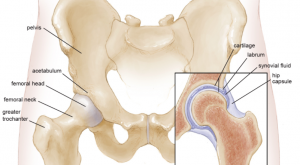Hip pain
 The hip joint is a ball and socket joint. The ball is part of the top of the thigh bone, or femur. The socket is part of the pelvis. The ball is referred to as the femoral head and the socket as the acetabulum. Around the rim of the acetabulum is a horseshoe shaped cartilage collar, this serves to increase the depth of the socket, improving hip joint stability.
The hip joint is a ball and socket joint. The ball is part of the top of the thigh bone, or femur. The socket is part of the pelvis. The ball is referred to as the femoral head and the socket as the acetabulum. Around the rim of the acetabulum is a horseshoe shaped cartilage collar, this serves to increase the depth of the socket, improving hip joint stability.
The joint capsule is formed of ligaments; soft tissue structures that attach one bone to another and help to stabilize the joint. The hip is also supported and moved by muscles surrounding the joint.
The muscles of the buttock are called the gluteal muscles, of which there are 3, maximus, medius and minimus.
On the front of the thigh are the four quadriceps muscles.
At the back of the thigh are the hamstrings.
The inner thigh is where the adductor muscles can be found. These muscles move the leg towards the midline.
One further muscle plays an important part in moving the hip; this runs from the lower back to the top of the femur and is called the iliopsoas.
The sciatic nerve is a large structure that runs past the back of the hip joint and is seen during surgery to replace the hip.
When the cartilage on the surface of the femoral head or acetabulum becomes worn we call this arthritis of the hip. Pain is experienced either in the groin on the affected side, or can be felt deep within the buttock. Typically the hip starts to become stiff and has a decreased range of movement. This can make everyday activities, such as climbing the stairs or getting in and out of the car, very difficult.
There are various treatments that can be tried before hip replacement becomes necessary. Click on the link below to access a decision making tool that will help you to decide which treatment might be best for you.
Shared decision making – osteoarthritis of the hip
Once a decision has been made by Miss Gill that joint replacement surgery is required it is important to ask any questions that you may have. Miss Gill will provide each patient with her consent information sheet, a copy of which can be found by clicking on consent information sheets box below.
